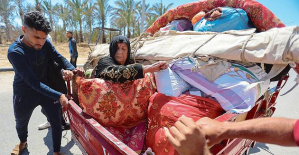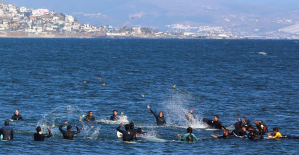Pride comes before a fall, and in war it can cost you your head very quickly. The Roman centurion Decrius had to experience this around the year 20 AD in the province of Africa Proconsularis. When his camp on the Pagyda River was besieged by insurgents led by Tacfarinas, the commander left the fortifications with his unit of around 500 men to confront the numerically superior opponent in the open field. That went completely wrong, Decrius had underestimated the supposedly savages. Most of the legionnaires fled, abandoning their centurion. Wounded by several arrows - one hit him in the eye - Decrius charged the enemy all alone and fell.
Cowardice in the face of the enemy had drastic consequences for the surviving Roman soldiers. Because as punishment for the debacle, every tenth man of the dishonored cohort was chosen by lot and beaten to death. From now on, the others received worse food, barley instead of wheat, which was actually intended as animal feed. According to the historian Tacitus, who describes the case in his "Annales", this particularly harsh collective punishment was actually no longer common at that time. But their terror resonates to this day - in the word "decimate".
Decimation, more common in Republican times, was one of many punishments and chastisements Roman soldiers had to fear. To maintain troop discipline, officers (the centurions) carried a vine (vitis) with them at all times, which was also a sign of their rank. Many made extensive use of the vitis - Tacitus records one particularly notorious centurion, nicknamed Cedo Alterum: 'Bring the next'. This was a reference to the many sticks he broke when beating his subordinates.
Soldiers often bribed their centurions to avoid punishment, which included fines, hard labor, or reduced vacation time for minor offences. The psychological punishment of humiliation was also common, with delinquents being deprived of their most important status symbol, the sword belt (cingulum militare). Those humiliated in this way only regained their belts when they had redeemed themselves through performance.
Serious misconduct could be punished with mutilation, such as cutting off a hand. And crimes like desertion carried the death penalty, which was carried out in a variety of ways. This ranged from the comparatively sober variant of decapitation with a hatchet or sword to being burned alive. Later, soldiers were also nailed to the cross or thrown to wild animals to eat. Up until the 1st century soldiers were exempt from this type of punishment as a form of privilege.
Privilege – that is also an answer to the question of why young men were willing to submit to such a rigid system in large numbers. The legionaries of Rome were the epitome of the middle class, they numbered around 300,000 men in the high imperial period.
They were also the only ones who received a regular income with social benefits that are still relevant today: free health care, continued payment of wages in the event of illness, high performance bonuses (such as a share of the spoils in the event of war or endowments when there is a change of government), fantastic pensions. Opportunities for advancement were also excellent. Honorably discharged soldiers could easily rise to the elite of the provincial towns. No wonder, then, that the approximately 10,000 vacancies per year were in great demand.
However, Rome's legions were a kind of class society: the legionnaires with whom Rome had conquered its world empire consisted of Roman citizens. Their approximately 30 legions with about 150,000 men were assigned an equal number of auxiliary troops. These were units recruited from the provincial population or from strong fighting tribes living near the border. Tacfarinas, whose troops killed the Roman centurion Decrius, had served as an auxiliary before his rebellion against Rome.
The members of the auxiliary troops were paid less than the legionnaires. At the end of their 25-year service, they received Roman citizenship. On the other hand, the maintenance of the army devoured the bulk of imperial tax revenue, especially since the armies of the imperial era were only rarely used for lucrative conquests such as in Dacia, but usually served to secure peace.
Of course, there were draconian punishments not only for Rome's military, but also for the civilian population. Here, too, there was no general equal treatment: holders of Roman citizenship were executed in a different way than subjects. But Romans were not the same either. Members of the upper classes of society (honestiores = honorable) were subject to different implementation regulations than the "lower" (humiliores).
This social discrepancy was already evident in two traditional forms of execution dating back to the founding of the republic. After that, treason against the state was punished by falling from the Tarpeian Rock. The location alone had the highest symbolic value, as it was a slope on the Capitoline Hill, on which stood the most important temple in Rome and at the foot of which the Roman Forum stretched. During the Principate period, the emperors took up this tradition again in order to execute high-ranking conspirators in front of their peers.
Another atavistic death penalty, bagging, was used for family tragedies. Anyone who had abused their parents, grandparents or siblings was sewn into a sack along with snakes, dogs, monkeys or cats and then sunk in the Tiber. As a result, the delinquent did not receive a proper burial, which made his path to the underworld much more difficult or even impossible. Incidentally, this punishment was still used in the Balkans in the 19th century.
Probably the most common death penalty imposed on Roman citizens was beheading. Whereas in the republic it was usually carried out with an axe, in the imperial era the sword was increasingly used. This also reflected the growing influence of the military in the penal system after the establishment of the Principate.
Mass deaths also occurred in the arena. In the Colosseum in Rome alone, around 300,000 people are said to have lost their lives between its opening in 80 AD and the end of the gladiator games around 400. Most of them were probably prisoners of war and those who had just been sentenced to death, free and slaves alike. The judgment "ad bestias" (to the wild animals) meant the appearance in the morning program of the gladiator games (munera), with which aristocrats and emperors courted the favor of the masses.
Public crucifixion, a particularly dishonorable punishment, was reserved for rebels, whether slaves who had risen up against their masters, or non-Roman subjects who had the same intentions. After the Spartacus rebellion in 71 B.C. the surviving slaves were crucified by the thousands on the Via Appia. When, after Herod's death in 4 B.C. When there was unrest in Palestine, the governor Publius Quinctilius Varus had 2000 Jews crucified.
The differences between "honorable" and "lesser" were also reflected between strangling and burning. Members of the lower social classes, especially non-Romans, were cremated. The spectrum of offenses ranged from troublemaking to adultery and counterfeiting. In the seclusion of a prison, crimes against the state in particular were punished by hanging the guards. This could affect both Roman aristocrats and foreign leaders of rebellions, the most prominent being the Numidian Jugurtha and the Gaul Vercingetorix. Tacfarinas escaped that fate - he died in battle in 24.
You can also find "World History" on Facebook. We are happy about a like.

 Israel-Hamas war: Gaza between hope of truce and fear of Israeli offensive in the South
Israel-Hamas war: Gaza between hope of truce and fear of Israeli offensive in the South “Mom, Dad, please don’t die”: in the United States, a nine-year-old child saves the lives of his parents injured in a tornado
“Mom, Dad, please don’t die”: in the United States, a nine-year-old child saves the lives of his parents injured in a tornado War in Ukraine: Putin orders nuclear exercises in response to Macron and “Western leaders”
War in Ukraine: Putin orders nuclear exercises in response to Macron and “Western leaders” Mexico: the last moments of surfers found in a well, killed with a bullet to the head
Mexico: the last moments of surfers found in a well, killed with a bullet to the head A baby whose mother smoked during pregnancy will age more quickly
A baby whose mother smoked during pregnancy will age more quickly The euro zone economy grows in April at its best pace in almost a year but inflationary pressure increases
The euro zone economy grows in April at its best pace in almost a year but inflationary pressure increases Children born thanks to PMA do not have more cancers than others
Children born thanks to PMA do not have more cancers than others Breast cancer: less than one in two French women follow screening recommendations
Breast cancer: less than one in two French women follow screening recommendations “A potential environmental disaster”: Paris town hall opposes an oil drilling project in Seine-et-Marne
“A potential environmental disaster”: Paris town hall opposes an oil drilling project in Seine-et-Marne The governor of the Banque de France pleads for the development of French and European AI
The governor of the Banque de France pleads for the development of French and European AI Clariane (ex-Korian) announces a sale of its home hospitalization activities
Clariane (ex-Korian) announces a sale of its home hospitalization activities To everyone's surprise, the Hades 2 event video game is released in early access
To everyone's surprise, the Hades 2 event video game is released in early access The Origin of the World, exhibited at the Center Pompidou Metz, target of an “artistic performance”
The Origin of the World, exhibited at the Center Pompidou Metz, target of an “artistic performance” Threatened with death for having insulted the mobilized pro-Palestinian students, Élie Semoun files a complaint
Threatened with death for having insulted the mobilized pro-Palestinian students, Élie Semoun files a complaint Vienna, Paris, Milan celebrate the 200th anniversary of Beethoven's 9th Symphony
Vienna, Paris, Milan celebrate the 200th anniversary of Beethoven's 9th Symphony Cannes Film Festival: call for strike one week before opening
Cannes Film Festival: call for strike one week before opening Omoda 7, another Chinese car that could be manufactured in Spain
Omoda 7, another Chinese car that could be manufactured in Spain BYD chooses CA Auto Bank as financial partner in Spain
BYD chooses CA Auto Bank as financial partner in Spain Tesla and Baidu sign key agreement to boost development of autonomous driving
Tesla and Baidu sign key agreement to boost development of autonomous driving Skoda Kodiaq 2024: a 'beast' plug-in hybrid SUV
Skoda Kodiaq 2024: a 'beast' plug-in hybrid SUV The home mortgage firm rises 3.8% in February and the average interest moderates to 3.33%
The home mortgage firm rises 3.8% in February and the average interest moderates to 3.33% This is how housing prices have changed in Spain in the last decade
This is how housing prices have changed in Spain in the last decade The home mortgage firm drops 10% in January and interest soars to 3.46%
The home mortgage firm drops 10% in January and interest soars to 3.46% The jewel of the Rocío de Nagüeles urbanization: a dream villa in Marbella
The jewel of the Rocío de Nagüeles urbanization: a dream villa in Marbella Europeans: David Lisnard expresses his “essential and vital” support for François-Xavier Bellamy
Europeans: David Lisnard expresses his “essential and vital” support for François-Xavier Bellamy Facing Jordan Bardella, the popularity match turns to Gabriel Attal’s advantage
Facing Jordan Bardella, the popularity match turns to Gabriel Attal’s advantage Europeans: a senior official on the National Rally list
Europeans: a senior official on the National Rally list Blockade of Sciences Po: the right denounces a “drift”, the government charges the rebels
Blockade of Sciences Po: the right denounces a “drift”, the government charges the rebels These French cities that will boycott the World Cup in Qatar
These French cities that will boycott the World Cup in Qatar Foot: Italian football protests against a government project which aims to monitor club finances
Foot: Italian football protests against a government project which aims to monitor club finances Champions League: “We are ready for anything,” warns Edin Terzic before PSG-Dortmund
Champions League: “We are ready for anything,” warns Edin Terzic before PSG-Dortmund Premier League: David Moyes to leave West Ham at end of season
Premier League: David Moyes to leave West Ham at end of season Transat CIC: Yoann Richomme winner in the wake of Tabarly, Poupon, Peyron, Desjoyeaux...
Transat CIC: Yoann Richomme winner in the wake of Tabarly, Poupon, Peyron, Desjoyeaux...


















